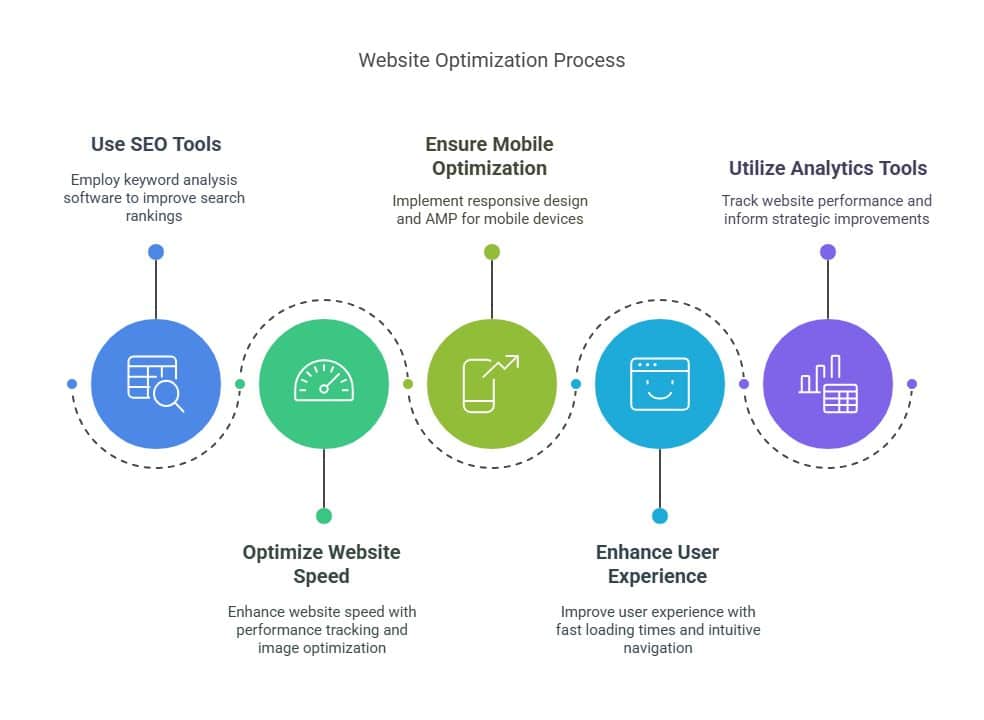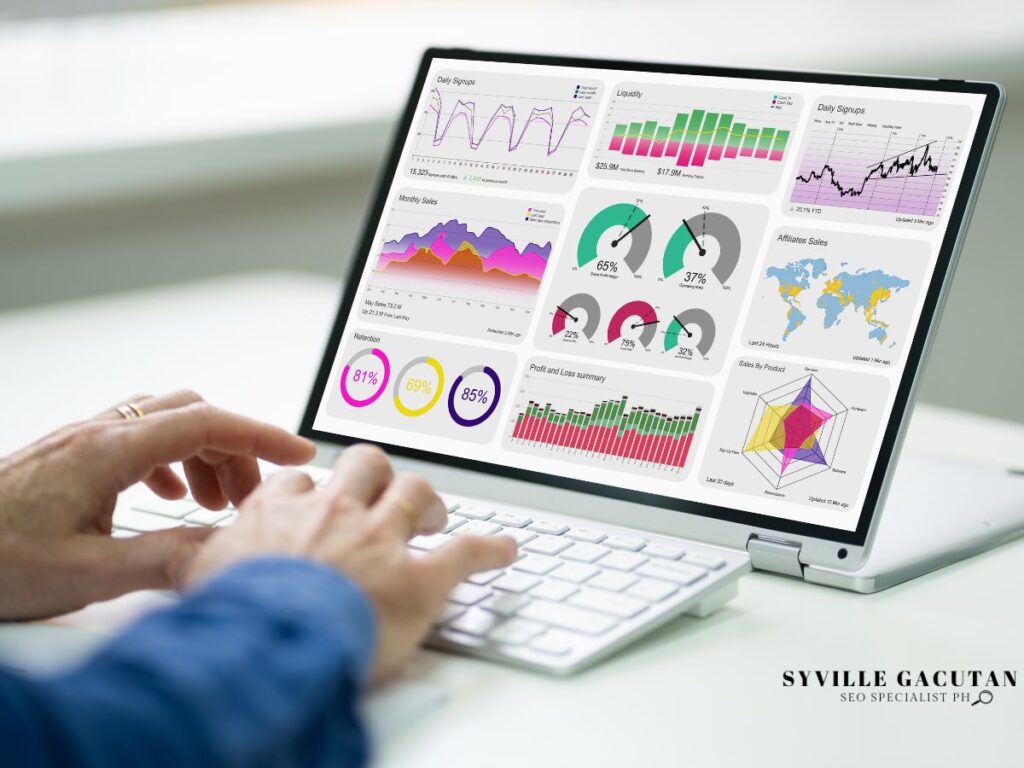
Guide to Using Digital Tools for Website Enhancement
Boosting a website’s speed requires carefully choosing digital tools from various areas. Begin by using SEO tools for analyzing keywords building links, & optimizing on-page elements to increase visibility. Boost website speed using performance tracking, image optimization, and CDN services, while mobile optimization tools ensure responsive design and faster mobile experiences. Elevate user experience with intuitive navigation and fast loading times. Employ website analytics for insightful data on user behavior and security measures like SSL certificates to safeguard user data. Regular monitoring with dynamic analytics tools supports proactive issue resolution. Discover further strategies and tools to refine your website effortlessly.
Key Takeaways
- Use SEO tools like keyword analysis software to improve search rankings and website visibility.
- Optimize website speed with performance tracking and image optimization tools for better user experience.
- Ensure mobile optimization through responsive design and Accelerated Mobile Pages (AMP) implementation.
- Enhance user experience with fast loading times, intuitive navigation, and user feedback mechanisms.
- Utilize comprehensive analytics tools to track website performance and inform strategic improvements.

Choosing the Right SEO Tools

Nowadays a website needs to rank highly in search engines for people to find it easily. This makes choosing the right SEO tools very important for businesses. The power of effective digital marketing tools lies in their ability to refine and enhance a company’s online presence, driving increased traffic and fostering higher conversion rates.
To optimize your website, it is essential to employ a strategic assortment of SEO tools that address diverse aspects of search engine optimization.
One of the primary tools for improving website optimization is keyword analysis software. These sophisticated tools provide insights into the most relevant and high-performing keywords within an industry, allowing businesses to tailor their content to meet audience demand and search intent. By leveraging these insights, companies can ensure their website ranks favorably in search results, thereby enhancing visibility and authority.
Building backlinks is crucial and link-building tools help create a strong backlink profile.Backlinks are a testament to a site’s credibility, and acquiring high-quality links from authoritative sources can significantly boost a website’s SEO performance.
Furthermore, on-page optimization tools play a critical role by analyzing elements such as meta tags, headings, and content structure to ensure alignment with best practices for SEO.
Enhancing Page Load Speed
A website’s page load speed plays a key role in user experience and search engine ranking. In today’s fast-paced digital world seconds determine whether users engage or abandon a site. Improving website speed is essential for any business aiming to lead its market.
Not only does a swift website boost user satisfaction, but it also amplifies your site’s visibility on search engines. To achieve this, leveraging the right digital tools is paramount.
- Performance Tracking Tools: Platforms like Google PageSpeed Insights and GTmetrix are indispensable for tracking website performance. These tools for creating detailed reports allow you to pinpoint areas for improvement, offering a clear roadmap for effective website optimization.
- Content Delivery Networks (CDNs): CDNs such as Cloudflare or Akamai can drastically enhance website speed by distributing content closer to your users. By doing so, they reduce latency and server load, ensuring that your website remains swift and responsive, regardless of the user’s location.
- Image Optimization Tools: High-resolution images can be a major bottleneck in load times. Tools like TinyPNG and ImageOptim compress images without sacrificing quality, ensuring your pages load efficiently.
This optimization is crucial for maintaining a visually appealing yet fast website.
Optimizing for Mobile Devices
Mobile optimization stands as a critical pillar of modern web development, driven by the increasing prevalence of smartphones as primary internet access tools. In an era where the dominance of mobile devices reshapes how users interact with digital content, ensuring your website is mobile-friendly is not just an option—it’s a necessity for maintaining a competitive edge.
The power to captivate your audience lies in effective utilization of optimization tools, designed to enhance your website’s performance across various screen sizes and resolutions.
To achieve exceptional mobile optimization, employing cutting-edge digital solutions is paramount. These tools offer functionalities such as responsive design testing, image compression, and script minification, all of which are crucial for trimming unnecessary load times and delivering seamless user experience.
As smartphones continue to evolve, staying ahead requires a proactive approach to incorporating features like accelerated mobile pages (AMP) and progressive web apps (PWA), which significantly boost website performance by reducing latency and ensuring swift loading.
Moreover, leveraging analytics to monitor mobile engagement metrics provides invaluable insights into how users interact with your site on their devices. This data-driven approach facilitates targeted improvements, fine-tuning elements like navigation and touch responsiveness, thereby optimizing the user journey and reducing bounce rates.
Improving User Experience

Enhancing user experience is fundamental to creating a website that not only attracts but also retains visitors. In the realm of digital marketing strategy, the user experience serves as the backbone of your website’s success, directly influencing its performance and the overall digital presence of your brand.
Utilizing the right tools can help streamline this process, ensuring that every interaction a visitor has with your site is seamless and engaging.
To elevate user experience, consider these pivotal strategies:
- Responsive Design: Ensure your website adapts to various devices and screen sizes. A responsive design enhances accessibility and usability, which are critical to maintaining a strong digital presence.
When users can effortlessly navigate your site on any device, it enhances their overall experience and satisfaction.
- Fast Loading Times: Speed is a crucial factor in user experience. Employ tools that optimize your site’s loading times, reducing bounce rates and increasing user engagement.
A swift loading website not only improves user satisfaction but also boosts your website’s performance in search engine rankings.
- Intuitive Navigation: Simplify your site’s navigation to allow users to find information quickly and efficiently. Implement digital tools that analyze user behavior, offering insights into how you can refine your navigation paths.
An intuitive navigation system not only enhances user experience but also empowers users, making them feel in control and valued.
Utilizing Website Analytics

Understanding and leveraging website analytics is essential for optimizing your digital strategy and enhancing website performance. In the realm of digital dominance, grasping the intricacies of analytics tools to track user behavior is non-negotiable. These powerful tools provide insights that are critical for understanding website traffic and user engagement, paving the way for strategic enhancements.
Website analytics tools such as Google Analytics and Adobe Analytics offer a comprehensive overview of your site’s performance. They track key metrics, helping you to identify the strengths and weaknesses of your current digital setup. For businesses striving for excellence, understanding these metrics is crucial for conversion rate optimization. By analyzing user pathways and behavior, you can tailor your content and design to maximize conversion efficiency.
| Key Metric | Importance |
| Bounce Rate | Indicates user engagement levels |
| Conversion Rate | Measures success of goals and actions |
| Traffic Sources | Identifies where visitors are coming from |
Each metric in the table above serves a distinct purpose in refining your digital approach. A high bounce rate may suggest a need for immediate user experience improvements, while tracking traffic sources can inform your marketing strategies. Conversion rate, being a direct indicator of success, is pivotal for evaluating the effectiveness of your calls-to-action and overall site functionality.
Boosting Security Measures

While website analytics reveal critical insights into user behavior and site performance, ensuring robust security measures is equally vital for maintaining user trust and safeguarding data integrity.
In an increasingly digital world, digital marketers need to prioritize security to optimize your digital performance. By employing the right digital tools, you can effectively protect your website content and enhance overall site resilience.
Digital tools enable powerful security enhancements through various strategies:
- Encryption Protocols: Implementing SSL/TLS encryption ensures that data transmitted between users and your website remains confidential and secure. This not only protects sensitive information but also bolsters user confidence in your brand.
- Firewall Solutions: Advanced firewall tools enable you to monitor and filter incoming and outgoing traffic, effectively blocking potential threats and unauthorized access. A robust firewall acts as your first line of defense against cyber intrusions, ensuring the integrity of your digital platform.
- Regular Security Audits: Conducting frequent security audits is paramount to identifying vulnerabilities within your website content and infrastructure. Tools that automate security checks and updates play a crucial role in maintaining a secure digital environment by optimizing your digital defenses.
Digital marketers need to recognize that security is not a one-time effort but a continuous process that demands vigilance and adaptation to evolving threats.
By integrating these strategies, you not only safeguard your website but also enhance your digital performance, ensuring that your online presence remains resilient and trustworthy.
Empower your website with these robust security measures to fortify your digital domain against an ever-changing landscape of cyber threats.
Monitoring Website Performance

Effectively monitoring website performance is essential for ensuring optimal user experience and achieving business objectives. In the competitive digital landscape, businesses must leverage powerful tools to automate the assessment of their online platforms. By integrating cutting-edge technologies, organizations can gain a precise understanding of their overall website performance, identifying areas that require immediate optimization.
Analytics play a pivotal role in this process. Dynamic analytics tools provide comprehensive insights into user behavior, page load times, and server response times, among other critical metrics. These insights empower decision-makers to make informed choices, driving improvements that enhance user engagement and satisfaction. For instance, lagging page speeds can deter users, but with robust analytics, one can pinpoint the bottlenecks and address them efficiently.
Moreover, tools to automate performance monitoring offer the dual advantage of efficiency and accuracy. Automated systems constantly track website health, sending real-time alerts when anomalies or performance issues arise. This proactive approach ensures that potential disruptions are addressed before they affect user experience or business performance. The ability to swiftly respond to issues is invaluable, granting organizations a competitive edge.
Optimization efforts are also significantly streamlined with these tools. By continuously monitoring website performance, businesses can implement precise adjustments, whether it’s optimizing images, refining code, or enhancing server configurations. Such meticulous attention to detail not only improves performance but also strengthens the website’s overall resilience.
Final Thoughts
Using digital tools for website enhancement is key to building a fast, secure, and user-friendly online presence. From SEO optimization and page load speed to mobile compatibility and robust security, each tool plays a vital role in ensuring a seamless experience for visitors. Continuous monitoring and data-driven improvements enable you to stay ahead in the competitive digital landscape, fostering both user satisfaction and business growth. By integrating these strategies, you can create a resilient website that adapts to evolving technology and user expectations.
Ready to transform your website into a high-performing, user-friendly platform? Connect with Syville Gacutan, an experienced SEO Specialist in the Philippines. Get personalized strategies, expert insights, and hands-on support to enhance your site’s speed, security, and search visibility. Let’s take your website to the next level—reach out today!